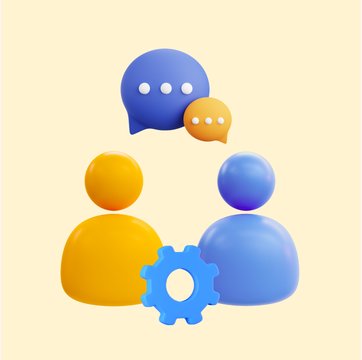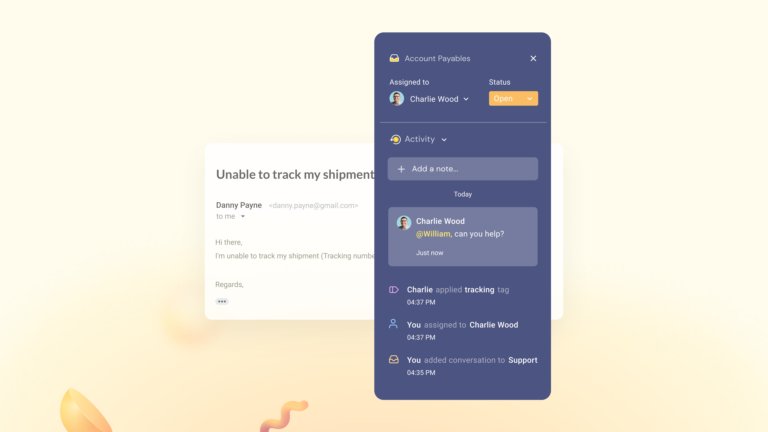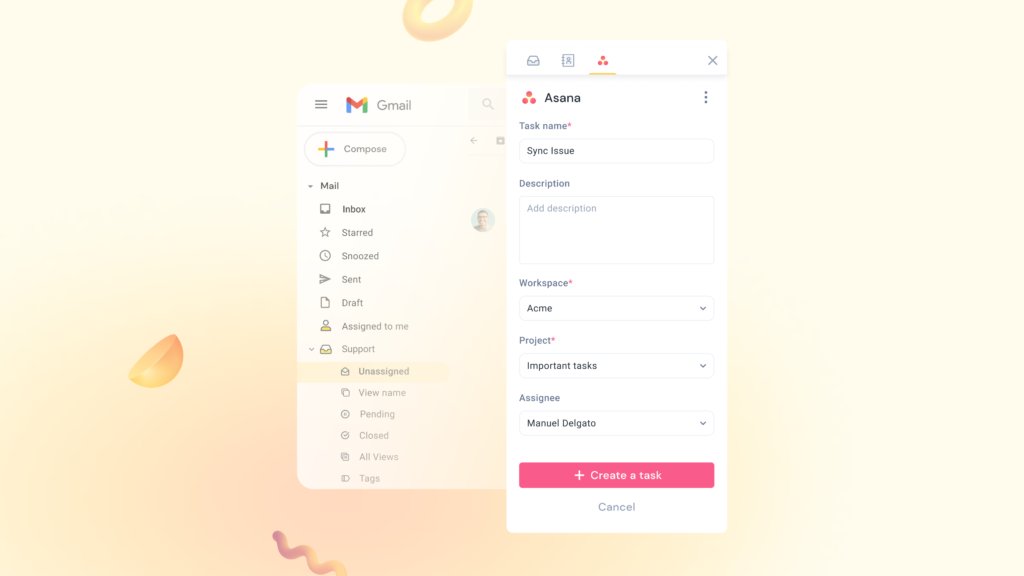
Table of contents
Transform Your Gmail Into A Helpdesk

5 Effective Strategies to Improve Cross-Team Communication in Your Organization

Table of contents
Cross-team communication is incredibly important in today’s workplaces.
When different teams in an organization – such as sales, marketing, customer support, and product development – communicate effectively between themselves, it leads to several benefits – work happens faster, delays and follow-ups reduce, and most importantly, customers get quicker support.
For example, in a software company, the product development team can regularly communicate with the customer support team to gather feedback and understand customer pain points. They can then use these insights to prioritize new features and improvements.
Similarly, the sales team can work together with the product team to develop a deep understanding of the product and its core features. This cross-functional collaboration gives them accurate information to help potential customers and address any questions or concerns effectively.
However, cross-team communication can prove to be tricky, especially in organizations that have several different departments and teams.
In this article, we take a look at:
- What is cross-team communication?
- Common challenges
- How you cam improve internal collaboration within your organization.
Table of Contents
- What is Cross-Team Communication?
- 5 Best Practices to Improve Cross-Team Communication for Your Business
- Benefits of Strong Cross-Team Communication
- Common Challenges with Cross-Team Communication
- Wrapping Up
- Frequently Asked Questions (FAQs)
What is Cross-Team Communication?
Cross-team communication refers to the exchange of information, ideas, and feedback between different teams or departments within an organization.
It involves individuals or groups from various parts of the organization sharing insights, collaborating on cross-functional projects, and coordinating efforts to achieve common goals.
Effective cross-team communication is essential for enhancing teamwork, problem-solving, and overall organizational efficiency. It ensures that different parts of the organization work together smoothly, avoid duplication of efforts, and align their activities to achieve shared objectives.
Teamwork is the ability to work together toward a common vision. The ability to direct individual accomplishments toward organizational objectives. It is the fuel that allows common people to attain uncommon results.
– Andrew Carnegie, American industrialist and philanthropist
5 Best Practices to Improve Cross-Team Communication for Your Business
Here are a few effective strategies that can help you pave the way for smoother cross-team communication in your company.
1. Establish Clear Communication Goals
Defining clear communication channels for team collaboration is important because it ensures that teams are able to connect easily, share information, and collaborate effectively.
It helps teams to align their efforts and leads to better teamwork and improved productivity.
This could look something like ensuring that every team uses Slack for all internal project discussions. Or making sure that any communication that involves the finance team is done through email.
So, how can you establish effective communication channels for better team collaboration?
- Establish Clear Communication Protocols: Define clear communication protocols, including how and when teams should communicate. This might include guidelines for email subjects, response times, and meeting agendas. For instance, all urgent emails should have the phrase “IMMEDIATE ACTION REQUIRED” followed by the topic of discussion in the subject line. This could look like: “IMMEDIATE ACTION REQUIRED: PRODUCT LAUNCH”
- Select Appropriate Channels: Choose communication channels that align with the organization’s needs and technology infrastructure. For instance, if you are a small organization with an employee size of 10-15, email might be the simplest way to enable cross-team communication.
- Escalation Chain: Define an escalation chain for issues that cannot be resolved at the team level. Specify who should be contacted and how, in case of escalation.
- Create Shared Documentation: Start creating shared documents, folders, or project management tools where teams can store and access important information, project updates, and relevant documents. Ensure these are organized and easily accessible.
- Create Cross-Team Email Lists: Establish email distribution lists that include relevant members from each team involved in cross-team projects. This simplifies communication and ensures that updates reach the right people. For instance, say you want to ensure that all updates regarding customer onboarding reaches the right people. A cross-team email list for such a project would include email IDs of employees in customer success, sales and marketing, product, etc. The email list could be named as ‘Customer Onboarding Team’.
2. Use Collaboration Tools
Collaboration tools simplify cross-team communication by providing a digital workspace where teams can communicate, share information, work together on tasks, and get visibility into what’s happening on shared projects.
A good example of such a tool is Hiver.
Hiver is designed for teams on Google Workspace and it offers several robust features that make cross-team team communication a breeze.
Notes and @ mentions
Say you’ve tried to collaborate with your teammates over email for complex queries, especially ones involving multiple stakeholders. You will find that you will have to rely on endless CCs and forwards for discussions, leading to a lot of clutter and confusion. Even worse, you might end up losing important information.
This is where Hiver’s Email Notes come in handy.

These notes are present alongside email threads, helping teams collaborate with context. They are private, which means that internal conversations never get shared outside the organization.
Any time you want inputs from team members, all you have to do is @mention the relevant teammate in Email Notes and type your message. They will be instantly notified about it. In case you want to notify your entire team, simply write a note and mention @All.
For instance, say Charlie, a support agent needs help solving a complex customer query. He can simply @mention William, his manager and write a note. William gets notified immediately and can respond to the note.
Collaborators
Now say that you want to enable seamless cross-team collaboration. Hiver’s Collaborator feature enables you to do this at an organization-wide scale, right from Gmail.

For instance, say Fiona from the accounts team receives an invoice via email for a subscription to an email automation tool. She needs the head of marketing to approve this invoice so that she can proceed with the payment.
Fiona invites Kelly, the Head of Marketing, to collaborate on the invoice by @mentioning her in Email Notes. Kelly receives a private link via email through which she can join a collaboration space. Once this is done, Kelly can respond to Fiona and approve the invoice.
Third-party integrations
Hiver integrates with project management tools such as Asana and Jira so that your teams can easily collaborate on tasks, track the status of bugs, and more. The best part is that it’s all right out of Gmail, which means you don’t have to keep switching between tabs to get your work done.

Hiver also integrates with Slack. This allows you to get instantly notified on Slack any time an email conversation is assigned to you, making internal collaboration faster and smoother.
3. Regular Cross-Team Meetings
Regular cross-team meetings are essential for maintaining open lines of communication and ensuring that teams work together effectively.
This is especially important in complex projects involving multiple teams. Teams can discuss project milestones, timelines, dependencies, and potential roadblocks, ensuring that the project progresses smoothly. It also provides a form for collaborative problem solving.
Let’s take an example to illustrate. Company XYZ designs and manufactures consumer electronics. The company requires that their R&D team and marketing collaborate regularly to ensure that their product development efforts are consistently aligned with market demands and consumer expectations.
They achieve this by implementing biweekly sync ups between R&D and marketing. During every meeting, the R&D team shares updates on product development, and any technical challenges they are encountering. Similarly, the marketing team provides insights into market trends, customer feedback, and what sort of messaging is resonating with the buyer.
Aside from this, coordination between R&D and marketing also results in smoother product launches, with marketing campaigns ready to support new product releases..
Cross-team meetings work best when they are actioned regularly. The key is to understand the particular needs of each team and whether or not there are any critical projects that require inputs from other teams.
It could be brief daily check-ins not exceeding more than 15-20 minutes. Or you could hold weekly tactical meetings to review activities, metrics, and challenges on a week-to-week basis.
Some teams also meet bi-weekly or monthly to discuss, analyze, brainstorm and decide upon critical issues affecting long term success.
4. Clearly Define Roles and Responsibilities
Defining clear roles and responsibilities for cross-team communication is of paramount importance within organizations for several reasons:
- Minimizes Confusion: When team members know their specific roles and responsibilities in cross-team communication, it reduces confusion and ambiguity. Everyone understands their role in the process, which streamlines communication.
- Avoids Overlaps: Clear definitions of roles and responsibilities prevent teams from duplicating efforts or working on the same tasks independently. This efficiency saves time and resources.
- Enhances Accountability: When individuals are assigned specific roles, they become accountable for their part in cross-team communication. This accountability ensures that tasks and actions are completed as expected.
- Improves Communication Flow: With designated roles, information flows more smoothly between teams. Each team knows whom to contact for specific information or updates, reducing communication bottlenecks.
- Saves Time and Resources: Teams can avoid the time-consuming process of determining who should do what if roles are clearly defined from the start. This efficiency saves valuable time and resources.
For instance, say your company is working on developing a new product. The project will involve a number of cross-functional teams such as the development, quality assurance, documentation, and marketing.
Without clearly defining the responsibilities each team is accountable for, confusions can arise. For example, the product development team may assume that the QA team is responsible for writing user guides, causing delays.
You Might Also Like: How to Build and Organize Customer Support Teams
5. Cross-Team Liasions or Champions
You can appoint individuals from each team to act as liaisons or champions for cross-team projects.
Liaisons have a deep understanding of the goals, challenges, and processes of both their own team and the teams they liaise with. This understanding enables them to translate and clarify information when necessary, reducing misunderstandings and miscommunications.
Aside from this, liaisons can also work to align the goals and objectives of different teams. They help ensure that each team’s efforts are synchronized with the overall organizational goals, preventing conflicts and promoting a cohesive approach to projects and initiatives.
For instance, let’s take the same example as earlier where your company is planning to launch a new product.
In such a scenario, the ideal cross-team liaison would be a seasoned project manager, Sarah, who has prior experience handling product launches before. Sarah will meet with the heads of each department involved in the product launch. She makes sure that everyone understands the common objectives and importance of their contributions in the project.
She then creates a detailed project plan, complete with realistic timelines on the deliverables from each team. Sarah can also identify potential conflicts that can occur and works with the respective teams to help resolve them and ensure the product launch goes smoothly.
Benefits of Strong Cross-Team Communication
Here are some of the key benefits of cross-team communication:
- Enhanced Collaboration: Teams can work together more effectively, sharing ideas and expertise to achieve common goals.
- Higher Efficiency: When information flows smoothly between teams, it reduces back and forth and ensures that tasks are completed efficiently.
- Lesser delays and confusion: With clear communication, teams can focus on their tasks without confusion or misunderstandings.
- Improved Customer Satisfaction: Coordinated efforts between teams lead to a better customer experience . That’s because every team in the organization directly or indirectly serves the customer.
- Better Decision-Making: Effective cross-team communication ensures that decision-makers have access to comprehensive and up-to-date information from different teams. This information is crucial for making well-informed decisions that take into account all relevant factors.
Here is an example of how strong team collaboration has an impact in delivering excellent customer service.
Imagine a customer contacts your company’s customer service department with a complex issue related to a product they purchased. The customer service representative who is handling the query realizes that resolving this issue requires input from the product development team.
The rep then reaches out to product development, sharing all relevant information and context about the customer’s issue.
Both customer service and product development collaborate in real-time to identify the root cause of the problem and devise a solution.
As the teams work together seamlessly, they provide the customer with a coordinated response. The customer receives updates and a resolution in a timely manner because both departments were able to communicate and work together efficiently.
Now this kind of seamless cross-team communication won’t happen if teams are working in silos. That brings up the common roadblocks that organizations face when driving such collaborative efforts.
You Might Also Like: Internal Communication Practices for Customer Support Teams
Common Challenges with Cross-Team Communication
Typically, there are several challenges associated with seamless cross-team communication. Identifying these challenges is important to foster better collaboration and synergy among the various teams in an organization.
Here are some of the most common cross-team communication challenges:
- Silos: Teams may operate in isolation, hindering the sharing of data and information.
- Lack of Transparency: Some teams may not be aware of the activities or goals of other teams, leading to misunderstandings.
- Communication Tools: Different teams may use separate tools or platforms for communication, This may lead to messages getting missed or falling through the cracks.
- Communication Overload: Excessive communication can lead to information overload, making it challenging to focus on important messages.
Wrapping Up
Effective cross-team communication is key for successful collaboration within organizations.
It empowers teams to work cohesively toward common objectives, share knowledge, and overcome challenges more efficiently.
By implementing the strategies outlined in this discussion, organizations can create a communication-rich environment where information flows seamlessly between teams.
Frequently Asked Questions (FAQs)
1. What is cross-functional team communication?
Cross-functional team communication refers to the exchange of information and ideas among members of different teams or departments. Cross-team communication is important to achieve common business goals that require inputs from the different departments present in an organization.
2. What is an example of cross-team communication?
A good example of cross-team communication is the exchange of information and updates between marketing and product teams. The marketing team is responsible for promoting a new feature launch and they take help from the product team to develop resources for the promotion.
3. What is cross-company communication?
Cross company communication refers to interactions between teams or individuals from different organizations. This is essential to form partnerships, expand your customer base, initiate industry collaborations, and more.
4. How do you ensure cross-team communication?
You can ensure cross-team collaboration by establishing clear communication protocols and guidelines. There can be regular meetings where teams can catch up on the latest updates, share ideas, and understand the progress of projects. You can also leverage collaboration tools for smooth inter-department communications.
5. Why is strong cross-team communication important?
Strong cross-team communication enables teams to exchange ideas and information. This improves efficiency, minimizes delays, and increases customer satisfaction. This is because better cross-team communication enables teams to work together collaboratively on customer queries and issues.
6. How can Hiver improve cross-team communication?
Hiver’s collaboration capabilities such as Notes allow teams to communicate seamlessly without leaving their inbox. All you have to do is @mention the relevant teammate and type your message. They will be instantly notified about it. Aside from this, Hiver also integrates with third-party tools like Asana and Jira which further simplifies project management.
7. Can Hiver help with project management across different teams?
Yes, Hiver integrates with project management tools such as Asana and Jira, allowing teams to collaborate on tasks and track progress directly from their inbox.




































